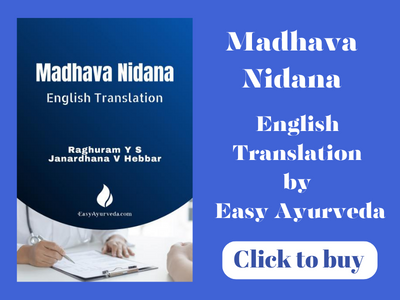Madhava Nidana Chapter 22 Vata Vyadhi Nidanam
This article explains Madhava nidana 22nd chapter “Vata Vyadhi Nidanam”. Causes, pathology and symptoms of Vata Vyadhi are explained in this chapter.
Read – Acharya Madhavakara: His Work ‘Madhava Nidana’, Legacy, Amazing Facts
Table of Contents
Vata Vyadhi Nidana
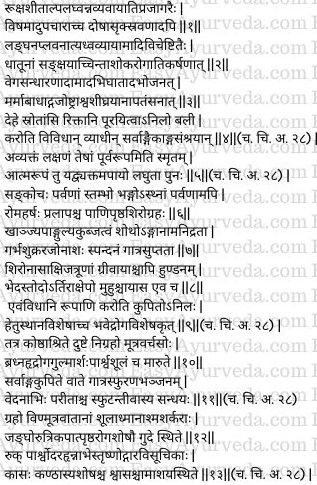
Causes:
Causes of Vata Vyadhi include –
excessive indulgence in foods which are dry, cold, scanty, light (quickly digestible);
sexual intercourse, keeping awake at nights, improper treatments (administering Panchakarma treatments at wrong times, in wrong conditions or consuming foods and activities which are incompatible as well as opposite to the nature of land and season), excessive discharge (elimination) of doșhas and blood from the body (during the course of treatments like emesis, purgation, bloodletting, etc.),
jumping, swimming, long distance walking and such other exercises and untoward activities (opposite to one’s nature);
loss or depletion of body tissues, worry, grief, extreme debility due to protracted diseases, habit of suppression of natural urges of the body, production of āma (undigested intermediary metabolites),
trauma, fasting or diseases of vital organs (pain or damage to vital organs),
riding fast on elephants, camels and horses (other similar animals or vehicles), or falling during such rides.
Vatavyadhi Samprapti
Pathogenesis – Due to the above said etiological factors aggravation of vata takes place and the channels (of vāta) in the body become empty or dry. This aggravated vata later occupies (fills) these channels and produces different diseases affecting one or more parts of the body. (1-4)
Read – Vata Dosha – Introduction, 40 Things To Know
Vata Vyadhi Purvarupa
Premonitory Symptoms of Vata Vyadhi
Premonitory stage of Vata Vyadhi is characterised by appearance of the symptoms of the disease which are in milder form. When the same symptoms (found in milder form in the premonitory stage) become well marked and severe, they denote the stage of manifestation of the disease (vata vyadhi).
On the other hand, absence of characteristic symptoms and lightness of the body (during the course of specific diseases to be described further on) are the signs of cure of such diseases.(5)
Read – Vata Disorders (Vatavyadhi): Definition, Causes, Symptoms
Vata Vyadhi Lakshanas
Vata Vyadhi
The general symptoms of vata vyadhi are – contractures of small joints of hands and feet (body parts), rigidity of joints, fracture & dislocation of joints including small joints of hands and feet, horripilation, delirium, stiffness (gripping pain, rigidity) of hands, back and head, limping and lameness of one or both legs, curvature of the back (hunchback), wasting of the body parts, loss of sleep, loss or destruction of foetus, semen and ovum (menstrual blood); tremors, and loss of sensation pain in the body parts.
This also occurs crookedness (drawing in of) head, nose, eyes, shoulders and neck; cutting or throbbing type of pain in the body parts, frequent convulsions and tiredness. These and other similar symptoms are produced by increased vata. The aggravated vata also produces special and newer diseases corresponding to the specific causes and sites of affection. (6-9)
Read – Symptoms Of Vata Dosha Increase And Imbalance – Vata Vruddhi Lakshana
Koshtashrita Vata
If the aggravated vāta is localised in the kostha (alimentary tract) there will be obstruction to passage of urine and faeces, enlargement of the scrotum (swelling in the groin), heart diseases, tumours of the abdomen, haemorrhoids and pain in the flanks. (10)
Sarvanga Vata
If vāta gets increased all over the body, there will be tremors (throbbing, twitching, pulsations, etc.) cutting, crushing and other types of pain, feeling of pain in the joints and the person feels as if there is a blast (bursting) in the joints. (11)
Guda Sthita (Gudagata) Vata
When the aggravated vāta gets localized and occupies in the gudā (rectum), it causes stoppage of movement of urine, faeces and flatus; pain (colic) and distension of the abdomen, formation of urinary gravel (calculus), pain in the calves, thighs, pelvis, legs (feet) and back and emaciation. (12)
Amashaya Sthita (Amashaya gata) Vata
If increased vāta resides in the āmāśaya (stomach) it causes pain in the flanks, abdomen, region of the heart and umbilicus, thirst, belching / eructation, vomiting and diarrhoea (occurring together), cough, dryness of throat and mouth and dyspnoea are found. (13)
Read – Gata Vata: Vitiated Vata Seated In Tissues, Visceral organs
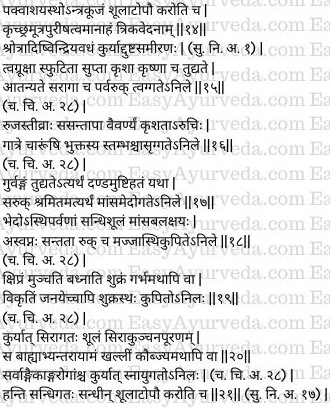
Pakwasaya Sthita (Pakwasaya Gata) Vata
If the aggravated vata gets lodged in the pakwāśaya (large intestine and rectum) it will cause intestinal gurgling and pain, gurgling sounds in the abdomen, difficulty for defecation and urination, flatulence (distension) of abdomen and pain in the sacral region. (14)
Srotradi Gata Vata
If vāta gets increased and localised in the Indriyas (sense organs) it will produce loss of function of those organs.
Twak Gata Vata
If the increased vata is located in the twak (skin), it produces dryness, cracks, loss of sensation, thinning, blackish discolouration, pricking pain, stretching, redness and pain in the small joints of the hands and feet (and other joints of the body). (15)
Raktagata Vata
If vata gets located in asrk (blood), it will cause severe pain, increased feeling of heat, discolouration, emaciation, loss of taste, appearance of ulcers or boils on the skin and stiffness of the body after meals. (16)
Read – Vatarakta: Causes, Pathogenesis, Types, Treatment
Mamsa Medogata Vata
If vāta gets lodged in māmsa and medas (muscles and fat) it produces a feeling of heaviness of the body parts (body parts would become heavy and inactive) associated with severe throbbing (pricking) pain and pain as though beaten by a stick or fist. The person would also experience severe pain in the entire body and extreme exhaustion. (17)
Majja-Asthigata Vata
When the aggravated vata is located in the majjā (bone marrow) and asthi (bone) it causes splitting pain in the bones and joints of the body including the small joints of the hands and feet, loss of muscles and strength of the body, loss of sleep and constant pain of the body.(18)
Read – Majja Pradoshaja Rogas – Diseases Due To Pathological Bone Marrow
Shukragata Vata
If the aggravated vata gets localized in the shukra (semen, reproductive tissue) it would cause premature ejaculation. Similarly, the foetus created by such shukra (sperm) would either be delivered too soon (aborted / miscarriage) or would be delivered too late. This vata would also cause abnormalities of sperm (semen) and embryo. (19)
Read – Apana Vata Location, Functions, Imbalance Symptoms, Treatment
Siragata, Snayugata, Sandhigata Vata
Siragata Vata – Vata (aggravated) located in the siras (veins and arteries) would cause pain, contractures or shortening and engorgement (with accumulation of blood).
Snayugata Vata – When the aggravated vata gets located in the snayus (ligaments, tendons, nerves) it would cause bow-like bending of the body either inwards or outwards, contractures of the fingers, shortening of the body due to the abnormal curvature of the back, and other diseases of either the whole body or any particular part or parts of the body.
Sandhigata Vata – If the aggravated vata is localized in the joints, it causes destruction of joints and their functions. Along with this, there also occurs pain and cracking sound (swelling) in the joints. (20-21)
Read – OsteoArthritis Symptoms, Prevention, Lifestyle tips, Ayurvedic treatment
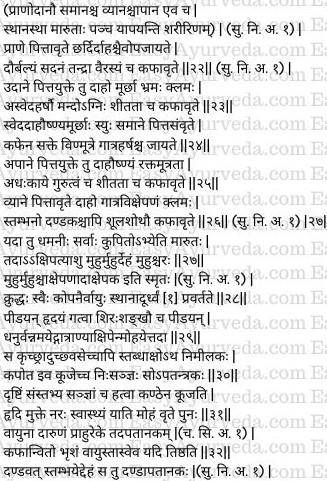
Avarana of Vata subtypes by Pitta and Kapha
Prana, Udana, Samana, Vyana and Apana are the five types of vata. In their normal state, these vata subtypes residing in their own seats would nourish and sustain the body and good health of the body.
Avarana is a condition wherein vata and its normal functioning and movements are clouded (encompassed, masked, surrounded, blocked, obstructed or interfered) by pitta, kapha, tissues, food or excreta. One subtype of vata can cause avarana of another subtype of vata also.
Pittavrita Prana – If prana vata gets obstructed by pitta the person would have vomited and burning sensation.
Kaphavrita Prana – If prana vata is encompassed by kapha, the person would suffer from debility, tiredness (loss of strength), stupor and bad taste (manifestation of opposite tastes) in the mouth.
Pittavrita Udana – When udana vata is encompassed or enveloped by pitta it produces burning sensation, fainting (unconsciousness), dizziness and exhaustion.
Kaphavrita Udana – If Udana Vata is encompassed or enveloped by kapha it causes loss of perspiration, loss of enthusiasm, poor digestive ability and feeling of coldness.
Pittavrita Samana – When Samana Vata is encompassed by pitta it gives rise to perspiration, burning sensation, increased temperature and fainting (unconsciousness).
Kaphavrita Samana – When Samana Vata is enveloped by Kapha, it causes obstruction to the elimination of urine and faeces and horripilations in the body.
Pittavrita Apana – When Apana Vata is encompassed by pitta it causes burning sensation, increase of heat / temperature and elimination of blood mixed urine.
Kaphavruta Apana – When Apana Vata is obstructed by kapha, it causes heaviness of the lower portion of the body (limbs) and feeling of coldness.
Pittavruta Vyana – When Vyana Vata is encompassed by pitta it gives rise to burning sensation, abnormal movements of the parts of the body and exhaustion.
Kaphavruta Vyana – If Vyana Vata is clouded by Kapha the body becomes stiff like a log. Along with this there is pain and swelling.
Read – Mechanism Of Avarana, Types, Importance of Vata
Akshepaka
When the increased vata gets localized in all the dhamanis (blood vessels) of the body, it produces quick, frequent and jerky movements of the body. Since there are repeated convulsions, this condition is called Aksepaka (convulsions). (22-27)
Apatantraka, Apatanaka, Dandapatanaka
Apatantraka and Apatanaka are the variants of Aksepaka.
Apatantraka – Vata undergoing increase by its own moves in an upward direction towards the head (leaving its seats of predominance like colon etc). While doing so, it causes pain in the heart, head and temples. It further makes the body bend like a bow and produces convulsions and loss of consciousness.
The patient will find difficulty in breathing, the eyes are kept wide open at times (without the movement of lids) and at other times they remain half closed (or lids completely closed). The person remains in a state of unconsciousness and makes sounds from within the throat like a pigeon. This condition which is a variant of aksepaka is called apatantraka.
Apatanaka – Apatanaka is yet another variant of apatanaka (described by other scholars) in which the patient will have completely fixed gaze (incapable of perceiving any visual objects), complete loss of consciousness, produces cooing sounds in the throat, and will have intermittent relief of symptoms when the heart (brain) becomes free from the affliction of aggravated vata but once again enters into a state of unconsciousness when there is another attack. This dreadful disease caused by severely aggravated vata is called apatanaka.
Dandapatanaka – This is a variant of apatanaka. If in apatānaka, vāta gets associated with kapha, the body of the patient will become stiff like a log of wood. This condition is called as Dandāpatānaka. (28-32)
Read – Ankylosing Spondilitis In Ayurveda – Pathogenesis, Treatment
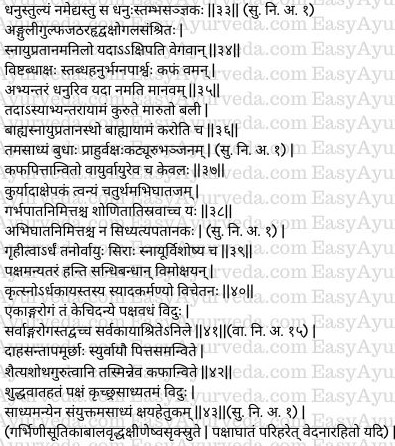
Dhanustambha, Abhyantarayama, Bahyayama
Dhanustambha – It is a condition wherein the aggravated vata makes the body bent like a bow.
Abhyantarayama (dhanustambha) – It is a variant of dhanustambha. Here the powerful (aggravated) vata affects the network of snayus (ligaments, tendons, nerves) located in the toes (and fingers), ankle joints, abdomen, and region of the heart, chest and throat. By doing so, it causes severe convulsive movements. The patient develops fixed gaze, stiffness of the jaw (lower) fracture (collapse or in-drawing) of the flanks, ribs), and vomiting of phlegm (mucus). Here the bending of the body will be inwards and is bent like a bow. This condition caused by severely aggravated vata is called as Abhyantharayama dhanustambha.
Bahyayama (dhanustambha) – It is also a variant of dhanustambha. When severely aggravated vata affects the tendons (nerves) of the external part of the body, the body of the person gets bent outwards like a bow. In this condition there is a threat of fracture (damage) to the chest, waist and thighs and hence is incurable. This condition is known as Bahyayama dhanustambha and in the opinion of scholars is an incurable condition. (33-36)
Read – How To Balance Vata Dosha? Line Of Treatment And Reasoning
Abhighataja Aksepaka
Dosha association in Aksepaka and symptoms of incurability of Apatanaka
Vata associated with kapha and pitta or even alone produces aksepaka. A fourth kind of aksepaka is caused due to trauma to the body parts and is called abhighataja aksepaka.
Apatanaka caused by abortions, excessive haemorrhage and trauma are incurable. (37-38)
Paksavadha
Pathogenesis and symptoms
The aggravated vata gets lodged in and affects any half side of the body (right or left side of the body), causes dryness (destruction) of the siras and snayus (blood vessels and ligaments / tendons / nerves), causes looseness of the joints and destroys the functions and sensation of half side of the body. This condition is called as Ekanga Roga by some people and Paksavadha by some others. When the entire body i.e., both halves of the body are affected in a similar way by the aggravated vata, it is called Sarvanga Vata. (39-41)
Dosha association and symptoms of incurability in Paksavadha
In the above disease (paksavadha), if vāta is associated with pitta, there will be burning sensation, increase of temperature of the affected parts and fainting (unconsciousness).
In paksavadha if vata is associated with kapha, there will be coldness, swelling and heaviness of the affected parts.
Pakşavadha caused by vāta alone is difficult to cure. Paksavadha caused by vata associated with other doshas (pitta and kapha) is easily curable. Pakdavadha caused by destruction of tissues (emaciation, wasting) is incurable. (42-43)
Other symptoms of incurability of Paksavadha
(Paksāghāta seen in pregnant women, in women who has recently delivered, children, old people, emaciated persons and that caused by heavy bleeding and that in which the patient has no pain (sensation) at all in the affected limbs (and affected parts) should be refused treatment because this condition is incurable.)
Read – Anantavata Shiroroga – Causes, Symptoms, Treatment
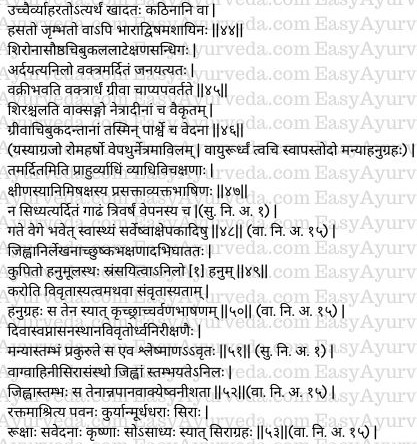
Ardita
Causes
Speaking in loud voice (high pitch) for long periods, eating (biting) hard food substances, excessive laughing (by opening the mouth), excessive yawning, carrying heavy loads on the head, and sleeping in uneven or irregular posture.
Pathogenesis
The vata getting aggravated by the above said etiological factors spreads to and occupies the head, nose, lips, chin, forehead and joints of the eye affects the face and causes a disease called as Ardita.
Symptoms
In this condition one half of the face gets crooked (deviated to the other side) and the neck also becomes crooked (turned outwards). There is also shaking of the head, obstruction of voice / speech (inability to speak), and deformities of eyes, nose, neck, jaw and teeth. The person also experiences pain (in the mentioned parts) on the afflicted side. (44-46)
Premonitory symptoms and symptoms of incurability of ardita
(The premonitory symptoms of ardita include horripilations, tremors, accumulation of dirt in the eyes (dirty looking eyes), belching (eructation), loss of sensation in the skin (of the face), pricking pain, stiffness of the neck and lower jaw.)
Expert clinicians call this disease Ardita.
Symptoms of incurability of ardita
Ardita is said to be incurable in emaciated persons, in those who do not wink their eyes, whose speech is slurred and incoherent and in whom ardita is persisting for more than three years. (47)
Attacks and episodes of Aksepaka and other disorders
In all types of aksepakas (convulsive disorders) the patient gets periods of health (normalcy) when the episodes of attack pass off. (48)
Read – Facial Paralysis- Ayurvedic Treatment, Medicines, Home Remedies
Hanugraha
Causes
opening the mouth in excess and for long periods (and also putting out the tongue) for the purpose of cleaning the teeth (brushing) and tongue with the help of brushes and tongue cleaners, eating foods which are dry, and injury are the etiological factors of hanugraha.
Pathogenesis
Due to the above said causes, the vata located at the root of the jaw causes loosening and dislocation of the joints of the jaw.
Symptoms
The mouth of the person will either remain open or closed tight all the time. This would cause difficulty in chewing the food as well as speaking. This disease is known as Hanugraha. (49-50)
Read – Sixth Nerve Palsy Symptoms, Treatment, Ayurveda Understanding
Manyastambha
Causes
Excessive sleeping during daytime, sleeping at irregular places and in irregular postures and looking in upward direction for long periods are the causes of manyastambha.
Pathogenesis and symptoms
Vata aggravated due to the above said etiological factors either singly or in association with kapha will afflict the sides of the neck and cause manyastambha.
Symptoms
Stiffness of the neck is the main symptom of this disease, which is also the name of the disease. (51)
Read – Stiff Neck Causes, Ayurvedic Treatment And Remedies
Jihvastambha
Jihva stambha (stiffness or loss of movement of the tongue) is caused when the aggravated vata affects the tendons / nerves near the voice box (responsible for the production of voice) and causes inability for chewing the food, drinking or talking. (52)
Siragraha
Vata increases, getting localised in the blood makes the blood vessels of the neck dry, painful and black coloured. This condition is known as Siragraha (or sirograha) and is incurable. (53)
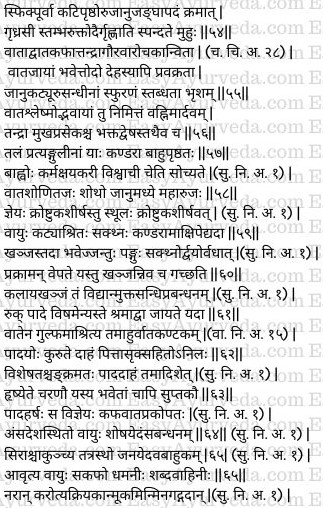
Gridhrasi
Pathogenesis of Gridhrasi
Vata either alone or associated with kapha produces (a disease called) Grdhrasi. This condition is characterised by a peculiar type of pain. The pain typically starts from the buttock and descends downwards encroaching (spreading in, radiating) the back portions of pelvis (lumbar region), thigh, knee joint, calf muscles (back of the leg – the portion of the lower limb between knee and ankle joints) and foot.
Vataja Gridhrasi
Due to this there is also (apart from pain) stiffness (inability to move), severe pain and throbbing (pricking pain) in the regions mentioned above along with repeated (and intermittent) pulsations. These symptoms are characteristic of Vataja (vata predominant) Grdhrasi.
Vata-Kaphaja Gridhrasi
In Grdhrasi if there is association of kapha with vata the person will experience stupor, heaviness and anorexia.
(Vataja Grdhrasi presents with pricking pain, crookedness of the body parts (irregular shape of the body parts), throbbing and severe stiffness in the joints of the knee, pelvis and thigh (hip). In Vata-Kaphaja Grdhrasi sluggishness of digestive fire / capacity (poor digestive capacity), stupor, excessive salivation and aversion towards food are predominantly seen as symptoms.) (54-60)
Read – Sciatica – Ayurvedic Understanding And Successful Treatment Options
Visvaci
Visvahci is an affection of the tendons / nerves of the fingers, the arms and the shoulders, leading to loss of function of the arm as caused by the aggravated vata.
The aggravated vata afflicts the tendons / nerves of the upper limb beginning from the back of the arm and reaching up to the back of the fingers and also involving the upper portions of the forearm and hands ultimately leading to the loss of functions in these regions. (57)
Read – Brachial Neuritis: Ayurvedic Treatment, Medicines, Remedies
Krostuka Sirsa
Vata and rakta getting affected together produces a very painful swelling of the knee joint (in the centre of the knee joint). The swelling is big and resembles the head of a fox and hence is known by the name Krostuka-Sirsa. (58)
Khanja and Pangu
Khanja – The aggravated vata gets lodged in the waist of the person, affects the tendons of one lower limb and causes loss of functions therein. This condition is called Khanja. Here the person cannot walk properly and experiences limping.
Pangu – When the aggravated vata, instead of one lower limb, affects the tendons and nerves of both the lower limbs and causes loss of functions therein the person would become lame. This condition is called as Pangu. (59)
Kalayakhanja
A condition in which there are tremors (in the legs, lower limbs) when the person begins to walk and later walks with a limp (limping gait, just like a person who has limp) is called Kalayakhanja. In this condition there is also looseness of the joints of the lower limb. This condition is caused due to excessive consumption of Kalaya (pea, lentil, masura dala) and hence the name Kalayakhanja. (60)
Read – Diet And Lifestyle Advice For Vata Dosha Body Type
Vatakantaka
Due to improper placing of the feet on the ground (walking on an irregular surface) while walking or exhaustion due to exertion of walking, the vata gets aggravated and gets localized in the ankle joints and causes severe pain therein. This condition is called as Vatakantaka. (61)
Padadaha
The vitiated Vata gets associated with pitta and rakta (blood) and causes burning sensation in the feet. The burning sensation is experienced more when the person walks. This condition is called as Padadaha. (72)
Read – Heel And Foot Arch Pain: Plantar Fasciitis Tips, Remedies
Padaharsa
Vitiated vata along with kapha produces a feeling of pins and needles or feeling of loss of sensation in the feet. This condition is called as padaharsa. (63)
Amsa Sosa and Apabahuka
Amsa Sosa – Vāta located in the region of the shoulder (shoulder blade) causes emaciation (of muscles) of the shoulder joint. (This is known as Amsa sosa.)
Avabahuka / Apabahuka – The aggravated vata located in the region of the shoulder (blades) causes constriction / dryness of the tendons / nerves located therein and causes another condition called as Apabahuka. (64)
Read – Frozen Shoulder: Ayurveda Treatment, Medicines, Exercises
Mukadi
The aggravated vata along with kapha invades and obstructs the shabda vahini dhamanis (vessels / nerves which are responsible for the production of voice, vessels and nerves around the voice box) and cause inability to speak in the person. The person would become mute or would develop nasal speech or stammer. (65)
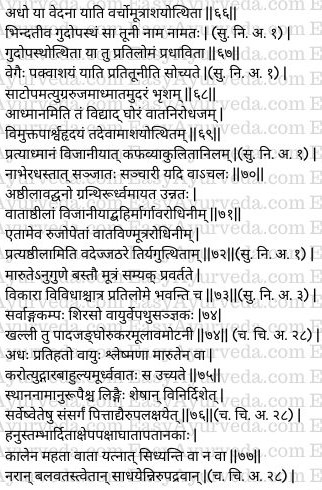
Tuni and Pratituni
Tuni – The disease in which severe cutting pain begins in the colon (rectum?) and urinary bladder and moves downwards towards anus and penis is called Tuni.
Pratituni – In this condition the movement of the pain is in reverse direction as compared to that of tuni. Here the cutting type of pain first starts in the anus and penis and moves upwards towards the colon (large intestine). Here the pain quickly moves up in bouts, as if thrown in an upward direction (colic). (66-67)
Read – Colitis In Ayurveda: Pathogenesis, Causes, Treatment, Diet
Adhmana and Pratyadhmana
Adhmana – Adhmana is a condition caused due to the obstruction to the movements of vata. It is characterised by gurgling noise in the abdomen (intestines), severe pain and distension of the abdomen. This is considered to be a dreadful condition (life threatening).
Pratyadhmana – When the same symptoms of adhmana manifest in the stomach excluding (not manifesting) the regions of flanks and heart and is caused by vata associated with kapha, it is known as Pratyadhmana. (68-69)
Vatasthila and Pratyasthila
Ashthila / Vatashthila – A tumour / cyst (like outgrowth / protuberance) occurring below the umbilicus, which is either mobile or immobile, hard like a stone, which projects upwards and causes obstruction to the passage of faeces and urine is called as Vatashthila or Ashthila.
Pratyashthila – If the same stony projection (as that found in ashthila) is found lying obliquely in the abdomen, produces pain and obstruction to flatus, faeces and urine it is called as pratyashthila. (70-72)
Read – Charaka Udara Roga Chikitsa – 13th Chapter
Mutravarodha
When the vata (present in the urinary bladder) has its normal downward movement (anuloma), it causes proper elimination of urine from teh urinary bladder. But when the same vata moves in an upward direction (pratiloma), it causes many disorders (like mutrakrchchra, mutraghata, ashmari etc). (73)
Kampavata / Vepathu and Khalli
Vepathu is that condition caused by vata in which there will be tremors in the entire body or all the parts of the body including the head. (Vepathu may occur with or without shaking or tremors in the head).
Khalli is that condition in which there will be cramps (distortions) of the foot (legs), calves, thighs, chest and wrist joints (arms). (74)
Read – Parkinson’s disease: Prevention, Ayurvedic Treatment, Remedies
Urdhvavata
Vata, getting obstructed in its downward movement either by kapha or by itself (another subtype of vata), begins to move upwards and produces too many belchings (eructation). This condition is known as Urdhvavata. (75)
Anukta Vataroga
Other vatavyadhi which are not explained
Symptoms of the remaining kinds of vata vyadhis are to be diagnosed with respect to their site of affection and names. Similarly, the association of pitta, kapha and ama with vata shall be inferred based on the existing symptoms (of the associated dosha in the disease). (76)
Incurability of Vata Vyadhi
Hanustambha, ardita, akshepa, pakshaghata, apatanaka, become severe and difficult to cure or even incurable with lapse of time. These diseases, in the availability of all equipments and facilities of treatment and with proper treatment being administered will sometimes get cured and sometimes not. Treatment of these conditions shall be attempted in patients who are physically strong and when they are not associated with complications. (77-78)
Upadravas
Complications of Vata
Visarpa (erysipelas), burning sensation, severe pain, stiffness of body parts (ankylosis) or non-elimination of flatus, faeces, urine, etc. fainting (unconsciousness), anorexia, poor digestive capacity, wasting of muscles, and loss of strength are the complications of vata vyadhi. In the presence of these diseases / conditions, the vata disorders such as paksawadha become fatal. (78)
Swelling of the body (or its parts), loss of tactile sensation, fractures of bones, tremors, distension of the abdomen (flatulence) or severe pain found in vata vyadhis are also to be considered as fatal signs. (79)
Symptoms of Prakrutastha Vata
The person in whom the movements (functions) of vata are not obstructed anywhere in the body, the subtypes of vata (Prana, Udana, Vyana, Samana and Apana Vata) remaining in their normal locations render normal functions, will live for hundred years without suffering from any disease. (80)
Thus ends the chapter on Vatavyadhi Nidanam in Madhava Nidana text written by Acharya Madhavakara.


